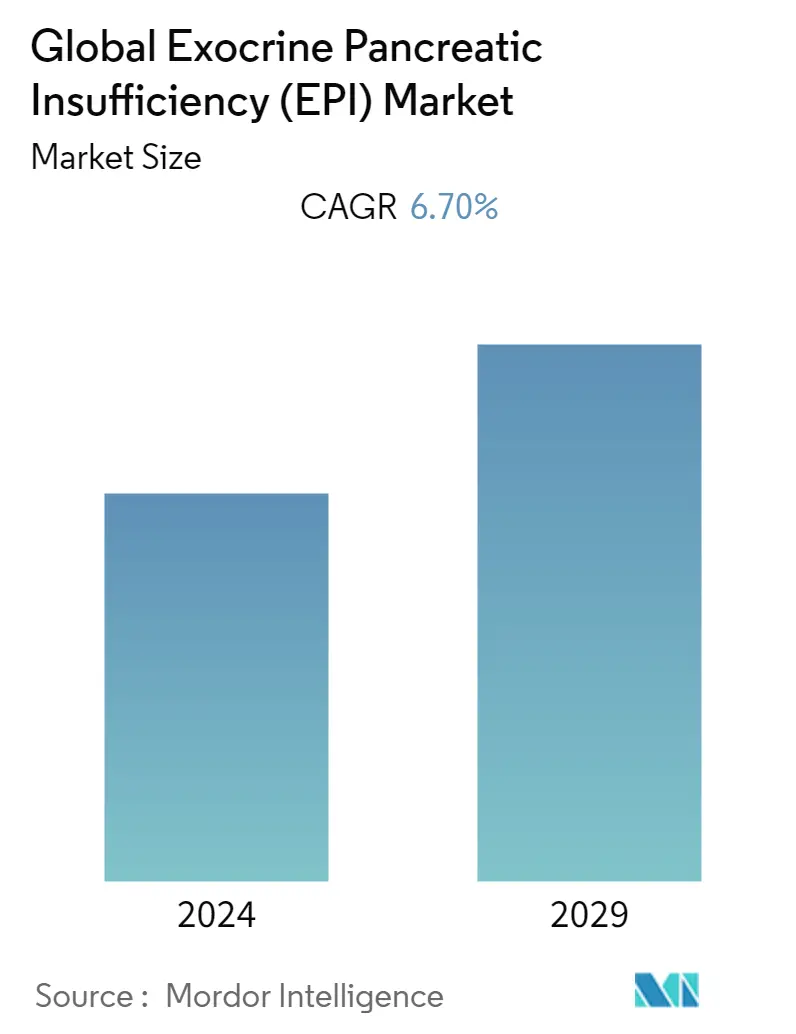Market Size of Global Exocrine Pancreatic Insufficiency (EPI) Industry

| Study Period | 2019 - 2029 |
| Base Year For Estimation | 2023 |
| CAGR | 6.70 % |
| Fastest Growing Market | Asia-Pacific |
| Largest Market | North America |
| Market Concentration | High |
Major Players
*Disclaimer: Major Players sorted in no particular order |
Need a report that reflects how COVID-19 has impacted this market and its growth?
Exocrine Pancreatic Insufficiency Market Analysis
The Exocrine pancreatic insufficiency (EPI) market is projected to register a CAGR of 6.7% during the forecast period (2022 - 2027).
Gastrointestinal symptoms, especially diarrhea, are common in infection with the novel coronavirus SARS-CoV-2. Angiotensin-converting enzyme-2 (ACE-2) receptors are highly expressed in enterocytes and serve as entry receptors for COVID-19. ACE-2 receptors may also be responsible for pancreatic damage in patients infected with SARS-CoV-2. According to a study conducted by Ni et al. 2020, both SARS-CoV and SARS-CoV-2 enter host cells via the angiotensin-converting enzyme 2 (ACE2) receptor, which is expressed in various human organs. For example, up to 67.0% of patients who developed diarrhea during SARS and a large number of patients with COVID-19 had intestinal symptoms. Diarrhea associated with SARS-CoV-2 is commonly thought to be caused by viral invasion of enterocytes. However, exocrine pancreatic insufficiency caused by SARS-CoV-2 is another likely mechanism leading to diarrhea in such patients. According to a study by Zippi et al., 2020, the gastrointestinal system can be affected by the infection of COVID-19, with a variable incidence from 3.0% to 79.0%. Therefore, the increasing number of cases of COVID-19 further leads to an increased number of cases of exocrine pancreatic insufficiency, and thus the market witnessed considerable growth during the pandemic.
Some of the factors driving the growth of the market include improved delivery system strategies. Bacterial engineering and gene transfer techniques could transform pancreatic enzyme delivery by producing enzymes in the host. Bacterial strains such as Lactococcus lactis - genetically modified to highly express bacterial lipases - have been derived. Several experiments are underway to demonstrate an effective delivery system, such as the colonization of subjects with experimentally induced pancreatic insufficiency with lipase-producing L. lactis, which has shown increased caffeic acid (CFA) on a high-fat diet.
The prevalence of exocrine pancreatic insufficiency is increasing majorly due to certain factors such as the increasing prevalence of the disease in cases of cystic fibrosis, chronic pancreatitis, and diabetes. Pancreatic insufficiency requires advanced therapeutics and the presence of a significant number of drugs. Recent trends in therapy include lipase therapy in dietetic patients and optimization of chymotrypsin and trypsin levels. However, in painful chronic exocrine pancreatitis, high-dose protease is thought to be beneficial. Severe cases are recommended for pancreatic replacement therapy along with pancreatin drugs. Esophagectomy was also associated with a rate of exocrine pancreatic insufficiency of 16.0%. Therefore, it is evident that exocrine pancreatic insufficiency can result in clinical manifestations and biochemical changes, causing reduced quality of life and life-threatening complications.
However, the treatment failure and lack of confidence in diagnosis and management are likely to impede the market growth over the forecast period.
